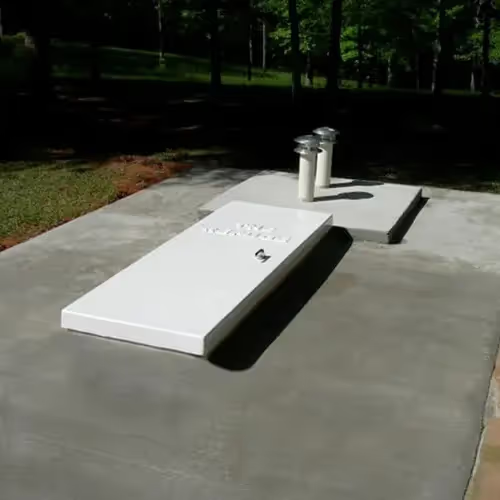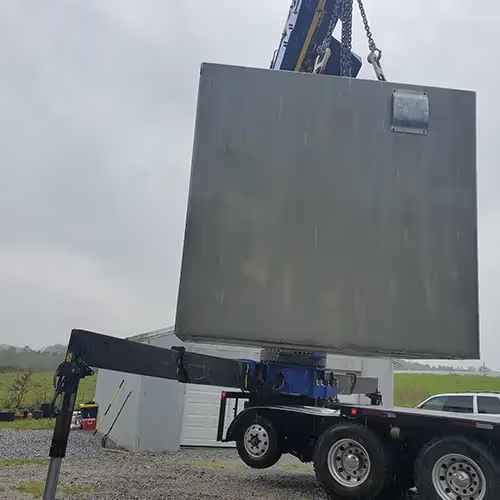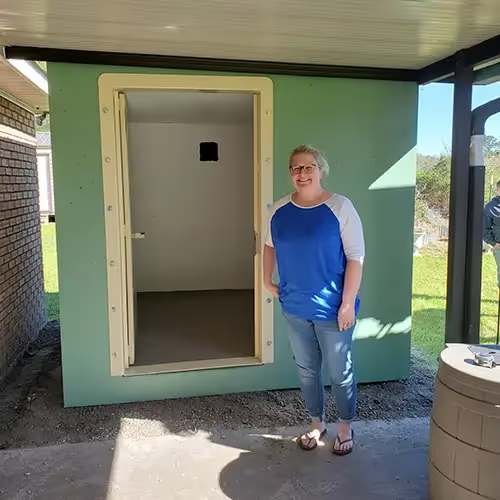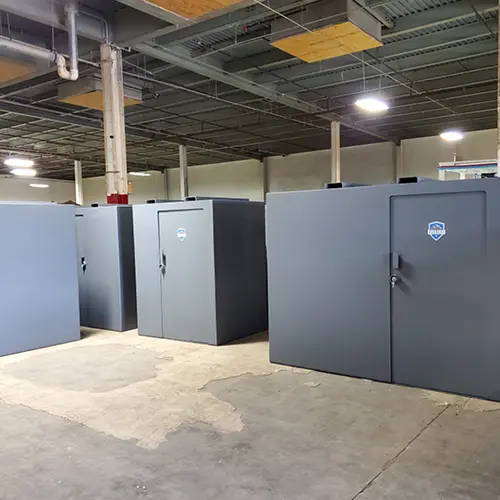Underground Storm Shelters in Alabama: Siting, Drainage, and Flood Risk


Have you ever considered where you’d go if a tornado struck your neighborhood tonight? It’s a question no one likes to dwell on, but for Alabama homeowners, understanding Alabama tornado shelter safety is critical. Tornadoes in Alabama are frequent and unpredictable, making planning ahead essential. An underground storm shelter provides peace of mind, but selecting the right location involves more than digging a hole in the yard. Proper underground storm bunker design ensures the structure withstands high winds, debris, and water intrusion.
Site selection is influenced by soil type, natural drainage, and flood risk. Installing a shelter in the wrong location can result in flooding or structural issues, so applying floodproof storm shelter tips and proper storm shelter drainage solutions is vital. Homeowners should also consider residential storm shelters Alabama options to find solutions suitable for their property and family size. Knowing Alabama tornado risk zones helps determine which areas require more robust shelters.
Using storm shelter installation services from trusted professionals ensures the shelter is safely constructed, while a storm shelter cost estimate allows families to budget effectively. Adhering to emergency storm shelter guidelines from FEMA and local authorities ensures the structure meets safety standards. By planning ahead, considering flood risk, and evaluating the site properly, homeowners can secure a safe refuge during tornadoes, giving their families confidence and protection when severe weather strikes.
The Evolution of Underground Storm Shelters in Alabama
Historically, families in tornado-prone areas relied on root cellars, dugouts, or reinforced basements as emergency shelters. These early solutions were functional but lacked standardized engineering for high-impact storms. As tornadoes became more frequent and severe in Alabama, the demand for best storm shelters Alabama grew, leading to modern solutions such as underground tornado bunker Alabama designs. Today, these shelters are purpose-built with reinforced steel, concrete, or fiberglass to withstand debris, high winds, and flooding.
Modern shelters also incorporate features like watertight seals, ventilation systems, and secure entryways. Awareness of safe room building codes Alabama ensures new construction aligns with safety regulations, while storm shelter site evaluation helps determine optimal placement. Homeowners are increasingly informed about drainage and soil conditions, emphasizing the importance of storm shelter waterproofing methods to prevent water intrusion.
The evolution from rustic dugouts to modern shelters also reflects advances in storm shelter drainage solutions, emergency storm shelter guidelines, and construction best practices. By understanding this history, homeowners can make informed decisions about DIY underground storm shelter projects or professional installations. Choosing the right location, materials, and design ensures the shelter will protect occupants during tornadoes, flooding, and other severe weather events, combining safety, comfort, and long-term reliability.
Key Factors in Siting an Underground Storm Shelter
Location is just as important as construction when it comes to underground shelters. A poorly chosen site can result in flooding, structural issues, or accessibility problems. Factors like soil stability, drainage, water table depth, and proximity to the home play a critical role in flood-resistant shelter construction and overall Alabama tornado shelter safety. Proper safe room drainage planning ensures water is directed away from the shelter.
Key considerations include:
- Soil Conditions – Sandy or loose soils can shift, while clay-heavy soils may trap water. Soil type directly affects storm shelter foundation design and long-term durability.
- Drainage Patterns – Elevated areas allow natural runoff, reducing flood risk. Applying floodproof storm shelter tips and trench systems enhances safety.
- Water Table Depth – High water tables may cause seepage. For DIY underground storm shelter builders, monitoring groundwater is crucial.
- Proximity to the Home – Quick access is essential for tornado preparedness Alabama, but avoid interfering with utilities.
- Accessibility and Entry – Ensure clear paths free from debris or pooling water.
For instance, placing a shelter in a low-lying area can lead to water accumulation, while proper storm shelter site evaluation and storm shelter drainage solutions create a secure, dry refuge. Consulting Alabama storm bunker contractors ensures correct installation, while residential storm shelters Alabama designs can fit any backyard. Thoughtful siting guarantees functionality, reduces maintenance costs, and maximizes safety during severe weather.
Benefits of Proper Siting and Drainage Planning
Proper siting and drainage planning enhance the effectiveness of a severe weather safe room and improve the long-term performance of an underground shelter. Correct placement keeps water away, minimizes soil erosion, and ensures accessibility during emergencies. When homeowners invest in storm shelter foundation design and storm shelter waterproofing methods, they reduce maintenance and extend the shelter’s lifespan.
Advantages include:
- Reduced Flood Risk – Proper drainage prevents water infiltration, a key concern in flood mitigation storm shelters.
- Enhanced Safety and Reliability – Shelters remain accessible during storms, supporting emergency storm planning tips.
- Lower Maintenance Costs – Preserves structural integrity, reducing long-term expenses.
- Longer Lifespan – Effective underground bunker maintenance keeps shelters functional for decades.
- Improved Comfort – Ventilation systems and dryness improve usability for families.
Families consulting best safe room contractors often see benefits immediately. Proper siting enhances resilience, allows quicker access to home tornado safe room Alabama, and reduces stress during tornado events. Even minor improvements in drainage or foundation design contribute significantly to overall safety. Investing time in proper site planning and applying storm shelter installation services ensures a secure, long-lasting refuge, providing peace of mind for Alabama homeowners and their families during tornado season.
Common Challenges and How to Overcome Them
Underground storm shelters provide protection, but challenges like flooding, soil instability, accessibility, ventilation, and cost must be addressed. Proper planning ensures shelters remain safe and functional while avoiding expensive mistakes. Consulting experts or reviewing emergency storm shelter guidelines helps navigate these issues effectively.
Common challenges include:
- Flooding Risk – Water infiltration is common without storm shelter drainage solutions and proper site planning.
- Soil and Site Limitations – Rocky, sandy, or clay-heavy soils complicate flood-resistant shelter construction.
- Accessibility Issues – Improper placement may impede quick access to a residential storm shelters Alabama location.
- Ventilation and Moisture Control – Underground shelter ventilation ensures airflow and comfort.
- Initial Costs – Incorporating drainage, reinforcement, or waterproofing can increase upfront expenses.
Solutions include selecting higher ground for tornado bunker site selection, installing French drains or sump pumps, and working with Alabama storm bunker contractors experienced in local conditions. Regular inspections with a storm shelter inspection checklist and consulting storm shelter warranty services help maintain long-term reliability. With proactive planning, homeowners can overcome challenges and ensure a safe, durable shelter for their family.
Practical Steps to Building a Safe and Reliable Underground Shelter
Building a reliable underground shelter involves careful planning, research, and professional support. Following structured steps ensures the shelter is safe, functional, and compliant with Alabama storm shelter regulations. Even DIY underground storm shelter projects can benefit from professional guidance.
Steps include:
- Assess Your Property – Check high and low points, water flow, and soil type.
- Research Local Regulations – Follow safe room building codes Alabama for permits and zoning.
- Select Shelter Type – Choose between prefab units, custom designs, or residential bunker installation.
- Plan Drainage and Ventilation – Implement flood mitigation storm shelters strategies with vent kits and pumps.
- Hire Experienced Contractors – Trusted storm shelter installation services ensure reliable results.
- Map Accessibility – Plan paths for quick access to a home tornado safe room Alabama.
- Schedule Maintenance – Use storm shelter warranty services and regular inspections.
Following these steps ensures proper siting, durability, and safety. Combining expert advice with emergency shelter construction guide insights creates a long-lasting solution. Every precaution, from drainage planning to ventilation, contributes to the shelter’s overall performance and reliability during tornado season.
The Future of Underground Storm Shelters in Alabama
Shelters are evolving with technology, construction methods, and climate awareness. Modern best underground bunkers for Alabama feature smart monitoring, eco-friendly materials, improved drainage, and virtual planning tools. These innovations enhance storm shelter material comparison, ventilation, and overall Alabama disaster preparedness.
Advances include integrated sensors, energy-efficient construction, and community-based shelters designed for multiple families. Homeowners benefit from improved safety, accessibility, and long-term reliability. Contractors and local governments are adapting to changing building codes and flood management strategies. These trends will shape the next generation of severe weather safe room designs, ensuring shelters remain functional, sustainable, and effective.
Wrapping Up
Underground storm shelters in Alabama are about more than construction—they represent Alabama tornado shelter safety, preparedness, and peace of mind. Proper siting, drainage, and flood risk evaluation ensure long-term reliability. Applying storm shelter installation services, storm shelter cost estimate, and emergency shelter construction guide principles ensures shelters remain safe and functional for decades. By planning carefully and consulting experts, homeowners secure protection, comfort, and resilience for their families during tornado season and severe weather events.




